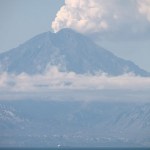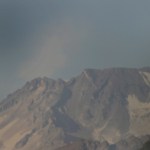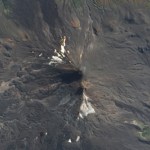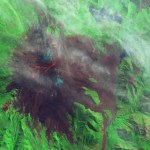Chile
The slow summer for volcanic eruptions continue. Only 11 updates in this week's USGS/SI report. Thanks again to SI's Sally Kuhn Sennert for compiling the news!
Highlights this week include (not including Kilauea) include:
Tungurahua in Ecuador produced some minor lahars on August 21 to go with steam-and-gas emissions.
Popocatépetl in Mexico produced an ash plume that reached ~8.2 km / 27,000 feet on August 20 and continued to produce steam-and-ash plumes throughout the week following.
Over on the Kamchatka Peninsula, both Koryaksky and Shiveluch produced significant ash plumes (reaching 3-5…
I knew that the minute I said I'd be back to a "regular" posting schedule that I would fail miserably, so maybe the less said, the better.
Cerro Galan caldera in Argentina (taken from space).
Thanks to all the readers who have been avidly discussing a number of fascinating topics over the weekend.
I have seen/read a little bit about the tectonic-forcing mechanism idea for some caldera-style eruptions. The biggest thing to keep in mind is that the caldera-forming event - that is to say the collapse of the roof into the chamber - isn't usually the "trigger" as much as a result of a large…
Chaiten in Chile erupting in January 2009. Even after over a year of activity, Eruptions readers are still captivated by the volcano.
Thanks for sending me your questions about volcanoes and volcanism. I'll try to tackle some hear - but as always, keep the questions coming! Send them to
For those of you who have submitted a question but don't see the answer here, do not fret. Likely it just means that I needed to do a little more research into the question and will get to it in a later mailbag!
So, without further ado ...
Mark M.: Here in the Appalachians we have very dense crystalline rock…
Busy busy analysing on the multicollector ICP-MS today (but not busy enough to miss this).
Here's your weekly volcano news roundup from the USGS/Smithsonian GVP.
Highlights (not including Sarychev Peak) include:
Continued dome growth and degassing at Bezymianny in Russia. Starting next year, there will be live webcams for three of the major volcanoes (Bezymianny, Kliuchevskoi, and Shiveluch) on the Kamchatka peninsula! Now, that is exciting news.
The glowing coming from the vent in the Halema'uma'u Crater at Kilauea in Hawai'i is still prominent. The lava levels in the crater have been…
We've already talked about how many active volcanoes reside in Indonesia, but this week's USGS/SI update just drives that point home. Listed in the update are no less than 5 volcanoes were activity is being seen or is on the increase (Karangetang, Slamet, Dukono, Batu Tara and Makian). This doesn't mean mention the activity at Anak Krakatau, Rinjani or Semeru. Amazing.
Anyway, highlights - not counting Indonesia or the South American trio - from this week's report (as usual aptly put together by Sally Kuhn Sennert) include:
A ~8,000 foot / 2.4 km ash and steam plume from Bagana in Papua New…
Volcano news ahoy, today brought to you by Islands.
Lake Kivu, located along the border the Democratic Republic of the Congo and Rwanda
A gorgeous satellite image (brought to us by the NASA EO) of a steam plume and ash from the ongoing eruption at Shiveluch in Kamchatka. The ash distribution stands out remarkably well on the white snow, with the central circle of ash near the vent/dome and then the wind-aided ash blanketing the terrain to the northeast of the volcano (and a little bit to the south).
Nature has a post reminding us that one of the big hazards at Nyiragongo/Nymuragira is not…
Here's the latest news from the USGS and SI Global Volcanism Program. It might not record every little volcanic noise in the world each week, but nothing like getting all the major volcanic events summarized on a weekly basis.
Highlights this week (not including Nyiragongo, Redoubt and Galeras):
The eruption at Rinjani in Indonesia continues, with elevated seismicity and 300-600 meter plumes.
Sporadic strombolian eruptions from the Crater C at Arenal, Costa Rica (since late April)
High seismicity, 100 meter domes and continued dome collapses continue at the two domes growing at Chaiten,…
Redoubt emitting a large steam plume in April 2009. Image courtesy of Calvin Hall.
A few snippets from the world of volcanoes:
The current eruptive cycle at Galeras continues to go strong. Officials with INGEOMINAS, the Colombian Geology Survey, believe the volcano will erupt again in the next few "days to weeks". The volcano last erupted a few weeks ago (in spanish) and caused quite a bit of panic in the city of Pasto at the foot of the volcano. An Orange Alert has been issued (in spanish) for the volcano.
Another volcano have is on the verge of a larger eruption is Nyiragongo in the DR of…
Some brief tidbits from the volcanic realms:
Active volcanism at NW Rota-1
Kilauea? Explosive? You might think of Kilauea as a volcano that generates impressive Hawaiian-style eruptions with fire fountains reaching 100s m and dazzling lava flows, but Don Swanson at HVO sees evidence of a big explosive event at Kilauea. This eruption was ~1,000-1,600 years ago and may have produced a plinian-scale eruptive column and threw cm-scale chunks up to 17 km from the vent.
The intermingling of life and active volcanism always seems counterintuitive, but when you're talking undersea volcanism, all…
Chaiten erupting in May 2008. Image courtesy of ONEMI.
Speaking of anniversaries, this weekend is the one-year mark for the Chaiten eruption (in spanish) in Chile, the first eruption at the volcano in ~9,000 years. Yes, indeed, the rhyolite eruption that caught most everyone by surprise is still going strong one year later, with two domes growing within the caldera (in spanish). The eruption produced some of the most impressive and sustained ash columns in years (see below) - climbing to 16 km/9 mi, abundant lahars and pyroclastic flows from the emergence and growth/collapse of the domes and…
Descabezado Grande, Chile showing increased fumarolic activity in 2009.
Well, if they didn't have enough already between Llaima and Chaiten, another volcano in southern Chile has started erupting. Descabezado Grande (roughly translated: "The Big Beheaded One") has erupted or is showing of eruption (in spanish and NOTE that the picture in the article is of Llaima, NOT, I repeat, NOT Descabezado Grande ... grrr) but details are scant on the actual activity. However, scientists from the SERNAGEOMIN are headed to the area to evaluate the volcano - hopefully the reports are accurate. So far,…
Stories in Spanish: Costa Rica becomes the first Central American country to confirm swine flu ("gripe porcina"). A 21 year old who had traveled to Mexico is in stable condition. An additional 16 cases were examined but were negative. Brazil is also examining 11 travelers; cases are also being examined in Panama, Honduras, Argentina, and Uruguay, and Chile.
In Asia, South Korea is examining a possible case, while China's stepped up its efforts to look for cases (and blocked import of pork from the US and Mexico).
Most of the cases that are being examined have traveled to Mexico…
Has a week gone by already? It is time for another USGS/Smithsonian GVP Weekly Volcano Activity Report.
Highlights (beyond Fernandina, Pagan and Redoubt) include:
A new underwater eruption at NW-Rota 1 in the Mariana Islands.
Increasing seismicity and incandescence from the rhyolite domes forming at Chaiten, Chile.
A spike in sulfur dioxide emissions from Kilauea, Hawai'i to 700 tonnes/day (up from a 2003-07 average of 150 tonnes/day).
4.5-7.5 km / 15-26,000 foot ash columns produced at Shiveluch in Kamchatka from new lava dome.
Continued dome growth and ~6 km / 26,000 foot ash columns from…
Well, after lamenting the slow volcano news, things are beginning to pick up again. Beyond the news of a potential increase in activity at Anak Krakatau, there are a few other newsworthy bits that have come up:
Mt. Kerinci in Indonesia
Mt. Kerinci in Indonesia is showing signs of eruption. The volcano is the highest mountain on the island of Sumatra, reaching 3,800 m / 12,400 feet and last erupted in March 2008. Its volcanic activity is marked by small (VEI 2) explosions of ash and tephra. Currently, the volcano is experiencing increased tremors and minor explosions that rained ash on a tea…
It has been rather quiet on the volcano-front in the last week. Redoubt and Llaima (in spanish), after a few weeks of intense eruption, are both back on Orange Alert. News of the eruptions from Hunga Tonga Hunga Ha'apai and Fernandina is rather sparse in the details. The news of volcanism in 2009 seems to have settled down.
A few tidbits I caught over the weekend:
Chaiten
Damage wrought by the eruption of Chaiten on the town of Chaiten in Chile, taken in early December 2008. Image courtesy of the NASA Earth Observatory.
Don't you feel like you're read this sort of story before after other…
The weekend is rolling in and I might end up spending most of it in the 90+ degree California weather, so unless something big comes up (volcanically), I'll leave you with a few news bits.
Llaima
Llaima in April 2009. Image courtesy of the NASA Earth Observatory
This is a true color image of Llaima in Chile, provided by the great folks at the NASA Earth Observatory. You can clearly see the dark grey new tephra on the main summit cone along with the grey ash covering the snow on the southwestern part of the volcano (north is up). A few other fun features are some smaller parasitic cones in…
Just a quick note before I'm off to this ...
Llaima
The SERNAGEOMIN is evaluating whether the alert level at Llaima should be lowered to Yellow in the near future (in spanish). Seismic acitivity at the volcano have come down since the eruptions started a few weeks ago and most of the activity now seems to be fumarolic in nature.
Popocatépetl
Popo (as it is also called) continues to produce steam/gas plumes (in spanish), 5 in one day on Monday of this week. However, all the other usual volcanic monitoring parameters (seismicity and the like) are unchanged according to Cenapred (National…
Fernandina, Ecuador
Fernandina erupting in 2009.
UPDATE 4/13/09 at 12PM: The NASA Earth Observatory has posted a nice MODIS image showing the plume from the Fernandina eruption drifting out over the Pacific.
We have a few more details on the ongoing eruption at Fernandina in the Galapagos Islands. Officials from the Parque Nacional Galápagos (PNG) flew over the island (in spanish) and saw the eruption is coming from a several-kilometer-long fissure vent that flows towards the sea, dividing into multiple flows and then coalescing when it reaches the sea. There is also a lot of vapor being…
Chaiten erupting on January 19, 2009. Image courtesy of the NASA Earth Observatory.
It is hard to believe that we are less than one month away from one-year anniversary of the beginning of the eruption at Chaiten (and with it, the one-year anniversary of this blog!) The volcano in southern Chile is still erupting away, creating at least 2 dome complexes within the older caldera. These domes have been experiencing periodic collapses, creating block & ash flows, some of which have made it out of the caldera and down close to the ghost town of Chaiten. Along with the block & ash flows,…
Llaima in Chile, taken on April 9, 2009. Image courtesy of the NASA Earth Observatory.
The NASA Earth Observatory (currently celebrating its 10th year) has posted a number of great images of the current eruption of Llaima in Chile, taken from Earth Observing-1 and Terra Satellites. They show both the ash plume of the eruption and the lava flows associated with it (above). The image here is a false-color image of Llaima, where the bright red/orange is the lava flow from the volcano, along with the dark brown of the ash/rocks from this and previous eruptions.
The eruption itself might continue…



